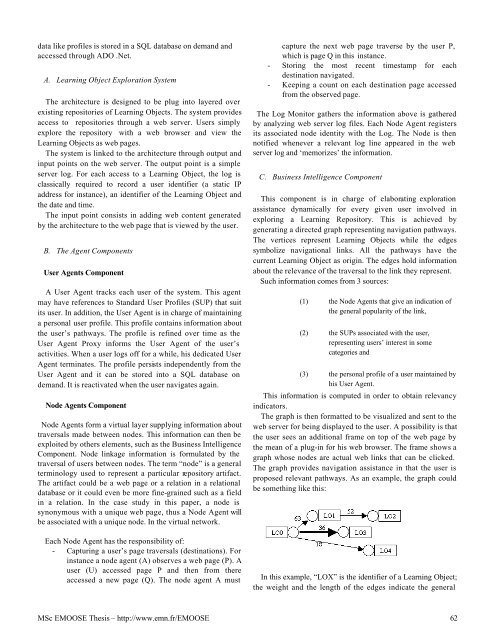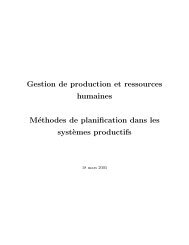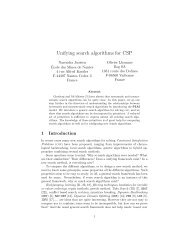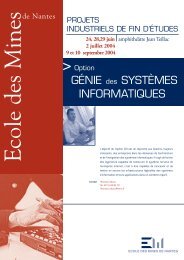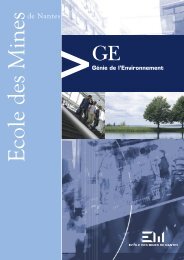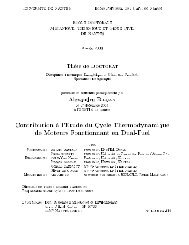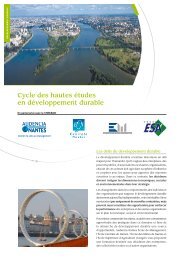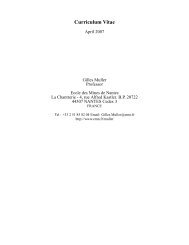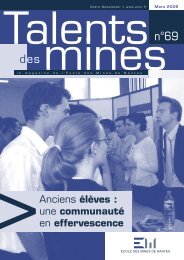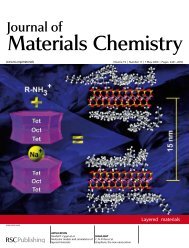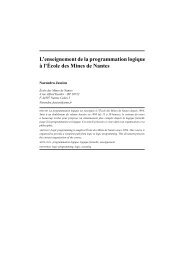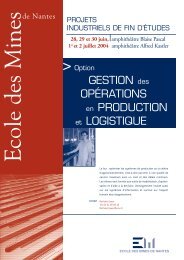pdf - 395 K - Ecole des mines de Nantes
pdf - 395 K - Ecole des mines de Nantes
pdf - 395 K - Ecole des mines de Nantes
You also want an ePaper? Increase the reach of your titles
YUMPU automatically turns print PDFs into web optimized ePapers that Google loves.
data like profiles is stored in a SQL database on <strong>de</strong>mand andaccessed through ADO .Net.A. Learning Object Exploration SystemThe architecture is <strong><strong>de</strong>s</strong>igned to be plug into layered overexisting repositories of Learning Objects. The system provi<strong><strong>de</strong>s</strong>access to repositories through a web server. Users simplyexplore the repository with a web browser and view theLearning Objects as web pages.The system is linked to the architecture through output andinput points on the web server. The output point is a simpleserver log. For each access to a Learning Object, the log isclassically required to record a user i<strong>de</strong>ntifier (a static IPaddress for instance), an i<strong>de</strong>ntifier of the Learning Object andthe date and time.The input point consists in adding web content generatedby the architecture to the web page that is viewed by the user.B. The Agent ComponentsUser Agents ComponentA User Agent tracks each user of the system. This agentmay have references to Standard User Profiles (SUP) that suitits user. In addition, the User Agent is in charge of maintaininga personal user profile. This profile contains information aboutthe user’s pathways. The profile is refined over time as theUser Agent Proxy informs the User Agent of the user’sactivities. When a user logs off for a while, his <strong>de</strong>dicated UserAgent terminates. The profile persists in<strong>de</strong>pen<strong>de</strong>ntly from theUser Agent and it can be stored into a SQL database on<strong>de</strong>mand. It is reactivated when the user navigates again.No<strong>de</strong> Agents ComponentNo<strong>de</strong> Agents form a virtual layer supplying information abouttraversals ma<strong>de</strong> between no<strong><strong>de</strong>s</strong>. This information can then beexploited by others elements, such as the Business IntelligenceComponent. No<strong>de</strong> linkage information is formulated by thetraversal of users between no<strong><strong>de</strong>s</strong>. The term “no<strong>de</strong>” is a generalterminology used to represent a particular repository artifact.The artifact could be a web page or a relation in a relationaldatabase or it could even be more fine-grained such as a fieldin a relation. In the case study in this paper, a no<strong>de</strong> issynonymous with a unique web page, thus a No<strong>de</strong> Agent willbe associated with a unique no<strong>de</strong>. In the virtual network.Each No<strong>de</strong> Agent has the responsibility of:- Capturing a user’s page traversals (<strong><strong>de</strong>s</strong>tinations). Forinstance a no<strong>de</strong> agent (A) observes a web page (P). Auser (U) accessed page P and then from thereaccessed a new page (Q). The no<strong>de</strong> agent A mustcapture the next web page traverse by the user P,which is page Q in this instance.- Storing the most recent timestamp for each<strong><strong>de</strong>s</strong>tination navigated.- Keeping a count on each <strong><strong>de</strong>s</strong>tination page accessedfrom the observed page.The Log Monitor gathers the information above is gatheredby analyzing web server log files. Each No<strong>de</strong> Agent registersits associated no<strong>de</strong> i<strong>de</strong>ntity with the Log. The No<strong>de</strong> is thennotified whenever a relevant log line appeared in the webserver log and ‘memorizes’ the information.C. Business Intelligence ComponentThis component is in charge of elaborating explorationassistance dynamically for every given user involved inexploring a Learning Repository. This is achieved bygenerating a directed graph representing navigation pathways.The vertices represent Learning Objects while the edgessymbolize navigational links. All the pathways have thecurrent Learning Object as origin. The edges hold informationabout the relevance of the traversal to the link they represent.Such information comes from 3 sources:(1) the No<strong>de</strong> Agents that give an indication ofthe general popularity of the link,(2) the SUPs associated with the user,representing users’ interest in somecategories and(3) the personal profile of a user maintained byhis User Agent.This information is computed in or<strong>de</strong>r to obtain relevancyindicators.The graph is then formatted to be visualized and sent to theweb server for being displayed to the user. A possibility is thatthe user sees an additional frame on top of the web page bythe mean of a plug-in for his web browser. The frame shows agraph whose no<strong><strong>de</strong>s</strong> are actual web links that can be clicked.The graph provi<strong><strong>de</strong>s</strong> navigation assistance in that the user isproposed relevant pathways. As an example, the graph couldbe something like this:In this example, “LOX” is the i<strong>de</strong>ntifier of a Learning Object;the weight and the length of the edges indicate the generalMSc EMOOSE Thesis – http://www.emn.fr/EMOOSE 62


